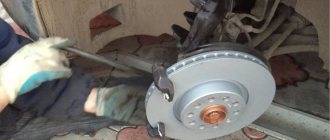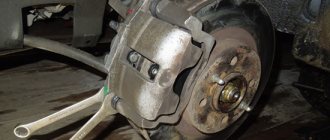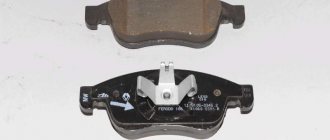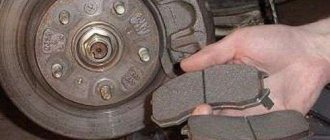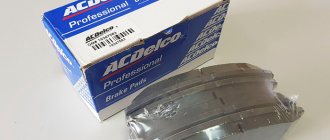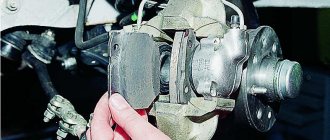The Volkswagen Polo sedan entered the Russian market in 2010, where it truly became the people's car. A distinctive feature of the car is its ease of repair, as well as the availability of inexpensive (both original and analog) spare parts.
One of the most important components of servicing any car is the timely replacement of brake pads. Repairing and servicing the brake system of the Polo sedan is not very difficult, but the owner still needs to know some nuances.
What pads were installed from the factory?
The Volkswagen Polo brake system has several variations. The front wheels on all cars are equipped with disc mechanisms. More advanced configurations have disc brakes on both the front and rear wheels.
In addition, there are differences in standard sizes. Depending on the engine power, larger and more wear-resistant parts were installed. Certain differences in the front brake units can be observed depending on whether the car is equipped with an ABS and ESP system.
But the main thing you have to pay attention to when changing pads is their markings. The presence of one or another marking, depending on the configuration and engine, is most conveniently presented in the following table.
| Engine | Marking |
| 1.4 TSI | 1 ZC |
| 1,6 | 1 ZE 1 ZG |
| 1.6 MPI (90hp) | 1 ZE |
| 1.6 MPI (110hp) | 1 ZC 1 ZE |
Each of the presented types has its own dimensions, in some cases they have almost identical parameters, and the main difference lies in the types of calipers.
For example, pads with the designation 1 ZE have the following dimensions:
- length - 131.2 mm;
- width - 52.5 mm;
- thickness - 17.8 mm.
For blocks with code 1 ZG the following parameters are inherent:
- length -146 mm;
- width - 54.7;
- thickness - 19.6 mm.
The sizes of the 1 ZC pads are represented by the following parameters:
- length -155.2 mm;
- width - 66 mm;
- thickness - 20.3 mm.
All pads manufactured and installed from the factory are designated VAG. This abbreviation classifies spare parts as original. The same replacement pads can be purchased both from an official dealer and from a regular retail chain of auto parts.
It should be noted that original pads are characterized by a somewhat inflated price compared to analogues. For example, 1 ZE pads with article number 6RU698151A can be purchased for an average of 2700-3000 rubles. Marking 1 ZG implies a slightly lower cost, in the range of 2400-2600 rubles (article number - 6R0698151A).
The most expensive original pads will be type 1 ZC pads. Their estimated cost starts from 2900 rubles per set (article number - 5K0698151).
What non-original pads can be installed?
The market for non-original spare parts is very inflated today. Manufacturers from all over the world are engaged in the production of so-called analogues. Therefore, it will not be at all surprising to find alternative pads on the Volkswagen Polo made in China or Indonesia.
The quality of many of these spare parts, of course, leaves much to be desired, and purchasing them would not be a rational waste of money.
However, there are a number of reliable manufacturers that made a name for themselves many years ago and produce spare parts for a wide range of cars. Spare parts from such a manufacturer in some cases may exceed the cost of the original due to increased performance characteristics.
When producing parts for budget brands, the price of new products may turn out to be much more interesting than that offered by the machine manufacturer.
According to reviews from car enthusiasts who previously installed analog pads on their Polo sedans, it follows that the following manufacturers of brake system elements, in particular pads, have the most optimal price-quality ratio:
- TRW;
- Ate;
- Brembo;
- Ferodo;
- Remsa;
For example, brake pads with code 1 ZE from TRW can be purchased for an average of 1350-1500 rubles (article number GDB2027). 1 ZG pads from Ate (article 13046071112) will cost a little less, around 1200-1300 rubles. Analog brembo coded 1 ZC article P85075 are offered at an average price of 1700-1800 rubles per set.
Catalog numbers (articles)
The question of which pads are best installed on the Volkswagen Polo V sedan can be answered unequivocally - only analogues, namely products from ATE or TRW. Their price per set is 2-3 times less than the original ones, but the resource is the same.
Article numbers of original pads
The originals are indicated in the spare parts catalog with the following codes:
| Caliper type | vendor code | average price |
| 1ZE | 6RU698151B | 2940 |
| 1ZE | JZW698151AK | 2113 |
| 1ZG | 6R0698151A | 2475 |
| 1ZG | JZW698151A | 1945 |
| 1ZC | 5K0698151 | 3043 |
Analogue articles for caliper 1ZE
| Manufacturer | vendor code | average price |
| ABS | 37957 | 2129 |
| ADR | ADR461911 | 595 |
| AMD | AMDBF388 | 705 |
| AVANTECH | AV1901 | 1301 |
| BAPCO | BP0457 | 732 |
| BARNETT | VV002 | 768 |
| BEHR HELLA | 8DB355020521 | 1676 |
| BLITZ | BB0192 | 773 |
| BRANNOR | BRP1776A | 5180 |
| BREMBO | P85121 | 2356 |
| DAFMI | D399E | 660 |
| DEQST | 10BPF00201000 | 678 |
| FRICTIONMASTER | MKD1776 | 1213 |
| FRICTIONMASTER | CMX1776 | 2025 |
| GANZ | GIJ09117 | 1193 |
| HQ | HQ6RU698151A | 683 |
| KONSTEIN | 5611586 | 1478 |
| LYNX | BD8035 | 1242 |
| MARSHALL | M2625681 | 900 |
| MILES | E500042 | 1037 |
| REMSA | 155300 | 1313 |
| SAT | ST6RU698151 | 721 |
| TEXTAR | 2568101 | 2221 |
| VIKA | 66981218501 | 1220 |
Analogue articles for caliper 1ZG
| Manufacturer | vendor code | average price |
| ABS | 37008 | 995 |
| ADR | ADR451211 | 450 |
| ADR | ADR460411 | 506 |
| AKYOTO | AKD1304 | 871 |
| AMD | AMDBF387 | 796 |
| AMIWA | CD01386 | 922 |
| ATE | 13046071112 | 1894 |
| ATE | 13047071112 | 3571 |
| AVANTECH | AV051 | 1252 |
| AYWI | AW1810156 | 898 |
| BAPCO | BP0186 | 857 |
| BEHR HELLA | 8DB355008591 | 1681 |
| BOSCH | 986495004 | 1529 |
| BRANNOR | BRP0768A | 5180 |
| BREMBO | P85041 | 1683 |
| BSG | BSG90200005 | 996 |
| CARLINE | CLN1088 | 979 |
| CIFAM | 8222111 | 2401 |
| COMLINE | CBP0737 | 1314 |
| DAFMI | D137E | 733 |
| DELPHI | LP1436 | 1394 |
| DEQST | 10BPF00014000 | 775 |
| DOUBLE FORCE | DFP1386 | 826 |
| EGT | 321573EGT | 623 |
| FEBI | 16328 | 2146 |
| FERODO | FDB1094 | 1751 |
| FRICTIONMASTER | MKD768 | 740 |
| GBRAKE | GP22004 | 1435 |
| GUD | GBP063300 | 754 |
| GALFER | B1G10203312 | 1190 |
| GANZ | GIJ09036 | 1155 |
| GIRLING | 6119842 | 1687 |
| HDE | 701028 | 665 |
| HELLA PAGID | 8DB355008591 | 1513 |
| H.S.B. | HP5149 | 1609 |
| IBERIS | IB153115 | 1072 |
| ICER | 181338 | 1319 |
| JURID | 571985J | 1678 |
| KAMOKA | JQ1012188 | 1743 |
| KAWE | 63320 | 2407 |
| KOTL | 1357KT | 819 |
| KOTL | 1984KT | 864 |
| KROSS | KV0500103 | 756 |
| KUJIWA | KUF0148 | 795 |
| LGR | LGR6195 | 833 |
| LPR | 5P730 | 878 |
| LYNX | BD8003 | 1032 |
| MARKON | 11000198 | 620 |
| MARSHALL | M2621974 | 909 |
| METELLI | 2202111 | 1377 |
| MEYLE | 252313019A | 1270 |
| MILES | E400054 | 782 |
| MINTEX | MDB2034 | 1704 |
| NIBK | PN0148W | 1788 |
| N.K. | 224740 | 1164 |
| PATRON | PBP1094 | 728 |
| PROFIT | 50001094 | 1130 |
| PROTECHNIC | PRP0223 | 1361 |
| QUATTRO FRENI | QF61000 | 706 |
| REMSA | 63300 | 1347 |
| RIXOS | MD8139WS10 | 1199 |
| ROAD HOUSE | 263320 | 1479 |
| SBS | 1501224740 | 1201 |
| SANGSIN | SP2025 | 1337 |
| SANGSIN | GP2025 | 1771 |
| SFEC | BP011104 | 985 |
| SRLINE | S700020 | 1048 |
| STELLOX | 644020SX | 768 |
| SWAG | 30916328 | 1415 |
| TEXTAR | 2313001 | 1895 |
| TEXTAR | 2313081 | 3906 |
| TOMEX | 1210 | 1309 |
| TRISCAN | 811029019 | 1353 |
| TRUSTING | 2201 | 1162 |
| TRW | GDB1984 | 2077 |
| VALEO | 301332 | 1473 |
| VIKA | 66980008701 | 750 |
| VITE | VBS1357PS | 566 |
| WEEN | 1511124 | 1016 |
| WOKING | P733320 | 1666 |
| ZEKKERT | BS1136 | 907 |
| ZIMMERMANN | 231301951 | 1638 |
Analogue articles for caliper 1ZC
| Manufacturer | vendor code | average price |
| 4U | 4UP03904 | 946 |
| ABE | C1A024ABE | 1427 |
| ABS | 37414 | 1487 |
| ACDELCO | 19374040 | 1521 |
| ADR | ADR451211 | 450 |
| AKYOTO | AKD23105 | 1106 |
| AMD | AMDBF415 | 936 |
| AMIWA | CD1256 | 961 |
| ATE | 13046071842 | 3355 |
| AVANTECH | AV1050 | 957 |
| AYWI | AW1810331 | 1074 |
| BAPCO | BP0280 | 999 |
| BARNETT | SK001 | 1256 |
| BEHR HELLA | 8DB355010581 | 2376 |
| BOSCH | 986424797 | 2383 |
| BRECK | 235870070110 | 1937 |
| BREMBO | P85075 | 2500 |
| CIFAM | 8225480 | 3122 |
| COMLINE | CBP11224 | 1538 |
| DAFMI | D194E | 1294 |
| DELPHI | LP1837 | 2011 |
| DEQST | 10BPF00012000 | 941 |
| DOUBLE FORCE | DFP1550 | 1049 |
| EGT | 321801EGT | 943 |
| FEBI | 16502 | 2009 |
| FENOX | BP43075 | 1130 |
| FERODO | FDB1641 | 2449 |
| FORTECH | FB1233F | 730 |
| FRANCECAR | FCR30B009 | 881 |
| FREMAX | FBP1351 | 1673 |
| FRITEC | SPC8212ZD1107 | 2962 |
| GBRAKE | GP22002 | 1938 |
| GUD | GBP103001 | 977 |
| GALFER | B1G10206802 | 2409 |
| GANZ | GIJ09007 | 1903 |
| GIRLING | 6115502 | 2406 |
| HELLA PAGID | 8DB355010581 | 2222 |
| IBERIS | IB153111 | 1400 |
| ICER | 181567 | 1735 |
| KAMOKA | JQ1013282 | 1878 |
| KEBONO | CD8388W | 1100 |
| KLAXCAR FRANCE | 24994Z | 1140 |
| KONSTEIN | 5610135 | 998 |
| KOTL | 1357KT | 819 |
| KUJIWA | KUF0348 | 913 |
| KUROSAI | KU75013 | 593 |
| LPR | 5P866 | 1409 |
| LYNX | BD1203 | 1173 |
| MAPCO | 6695 | 1564 |
| MARKON | 46522198 | 854 |
| MARSHALL | M2623587 | 1177 |
| MASUMA | MSE0012 | 1878 |
| METELLI | 2205480 | 1908 |
| MEYLE | 252358720W | 1712 |
| MILES | E500131 | 1412 |
| MINTEX | MDB2604 | 1888 |
| NIBK | PN0348W | 2487 |
| N.K. | 224770 | 1488 |
| PATRON | PBP1641 | 1166 |
| PROFIT | 50001641 | 1234 |
| Q FIX | Q0931106 | 1016 |
| QUATTRO FRENI | QF81000 | 830 |
| QUINTON HAZELL | BP1419 | 1379 |
| REMSA | 103001 | 2145 |
| RIXOS | MD8388WS | 1729 |
| ROAD HOUSE | 2103001 | 1992 |
| SANGSIN | SP1692 | 1848 |
| SANGSIN | SP2098 | 2006 |
| SAT | ST5N0698151 | 845 |
| SFEC | BP901837 | 1490 |
| SRLINE | S700069 | 1545 |
| STELLOX | 1041001BSX | 1144 |
| SWAG | 30916502 | 1668 |
| TOMEX | 1311 | 1936 |
| TRISCAN | 811029051 | 1743 |
| TRUCKTEC AUTOMOTIVE | 735137 | 1455 |
| TRUSTING | 5640 | 1836 |
| TRW | GDB1550 | 2706 |
| VAG | 5K0698151 | 4790 |
| VEMO VAICO | V108172 | 3029 |
| VIKA | 66980009201 | 932 |
| VITE | VBS1550PS | 1342 |
| WAGNER | WBP23587A | 1300 |
| WEEN | 1511252 | 1424 |
| WOKING | P1130301 | 1891 |
| ZEKKERT | BS1141 | 1332 |
| ZIMMERMANN | 235872001 | 2857 |
Replacing front pads on a Volkswagen Polo
Replacing the front pads is not a complicated procedure, but it does require special tools and some knowledge.
If there is no urgent need to save the family budget, and if there are official services or regular auto repair shops not far from home, then parts can be replaced there.
If you want to save a few hundred rubles, or you don’t have any desire to go to a service center, then the replacement can be done in your own garage or even on the street.
What tool will you need?
To replace the pads you will need the following tools:
- jack (it is impossible to replace the pads without removing the wheels);
- supports supporting the car (after lifting it on a jack);
- a wheel wrench for unscrewing the nuts or bolts that secure the wheel to the hub;
- a set of socket wrenches for removing brake calipers;
- a screwdriver for pressing out the piston and making it easier to remove old pads;
- pliers may be needed if it is necessary to bend the ends of the fastening brackets;
In addition, instead of a screwdriver, it is advisable to use a special tool to adjust the brake piston. It is a device with which the piston will be pressed into the cylinder, freeing up space for installing new pads.
Choice
The Volkswagen Polo is a fairly popular car, so many companies produce spare parts for it, including brake pads. When choosing them, it is advisable to give preference to original spare parts. How to change the front pads on a Polo Sedan? First you need to select certain tools:
- wheel wrench;
- jack;
- wheel chocks;
- socket wrench “12” or hex wrench “7”;
- slotted screwdriver;
- mount;
- pliers;
- copper or aluminum wire;
- dry clean rags;
- grease.
What else will you need to purchase to replace it?
To replace the pads, you may need some brake fluid, since after bleeding the brakes, its level may decrease slightly.
For faster lapping and running-in of new pads, you can use brake lubricant. But the main thing here is not to confuse it and not to apply it to the working surface of the pads. In this case, the effectiveness of the braking system will drop to a critical level, which is fraught with negative consequences.
For immediate replacement, a pair of cloth gloves will not hurt.
How to find out if replacement is necessary
Significant wear of the braking system is indicated by an unpleasant metallic grinding noise that occurs in the area of the front wheels when stopping a Volkswagen Polo car.
If such symptoms are present, it is necessary to urgently replace the front brake pads. The current situation cannot be left “for later”, as this can cause rapid complete wear of the car’s brake discs.
This vehicle has a special system that notifies you of significant wear of the brake pads installed in the car. They are made in the form of a thin steel strip attached to the base of the block made of metal. After severe wear of the material, the metal strip begins to touch the brake disc at the moment of braking, and an unpleasant characteristic sound appears. It notifies its “owner” about the critical condition of the installed brake elements.
Some trim levels have automatic systems that notify you when the brake pads are too worn. They operate on the principle of quickly closing the installed sensor with a contact to the ground of the vehicle during direct braking. This occurs by bringing the sensor closer to the brake system disc, which is isolated from the mass of the car by the sensor; it is located on one of the existing pads. At the same time, a warning light will light up in the cabin.
Step-by-step process for replacing pads
So, if the brake system fault indicator light comes on on the dashboard, then most likely it’s time to change the pads.
Having purchased the pads themselves, as well as the necessary tools and accessories, you can begin the procedure, which looks like this:
- we lift the car on a jack, and then firmly install it on supports;
- in the engine compartment we find a reservoir with brake fluid, remove the lid from it;
- unscrew the fasteners (bolts) securing the wheel rim to the hub, remove the wheel to the side;
- by selecting a socket wrench, we find the required diameter and unscrew the mount on the caliper, remove the caliper from the brake disc;
- using a screwdriver, press out the brake piston and, if necessary, remove the mounting brackets;
- remove the old pads;
- we lubricate the new spare parts with brake lubricant and install them in technological places, while using a screwdriver or a special device we press the piston so that the pads fit correctly into the required places;
- fix the calipers;
- We fasten the wheel, close the reservoir with a lid, and bleed the brakes.
After replacing the pads, especially if it was your first time, you should check the performance of the brake system at low speed.
Necessary tools and tools
To replace the front pads yourself you will need:
- dry and clean cloth.
- a piece of aluminum, copper wire or rope;
- key “12” or hex key “7” (depending on the design of the collet);
- adjustable pliers or a small crowbar;
- wheel wrench;
- wheel stops;
- connector;
- thick;
- insurance for the jack in the form of hemp, several bars or bricks;
- syringe with a volume of 20 cm3 or a bulb made of medical rubber;
- flat screwdriver (medium size);
Before you start replacing the pads, check the brake fluid level in the reservoir. If the container is filled to about 0, the liquid must be partially pumped out using a syringe or rubber bulb.
Then use a screwdriver to pry up the bushing covers covering the guide pins and carefully remove the covers.
First, pull out the lower caliper pin and pull it out.
We do the same with the second finger.
We carefully examine the condition of both the protective sleeves and the fingers themselves. If damaged, parts must be replaced. If the movement of the caliper relative to the guide is unsatisfactory, the threads of the mechanism must be lubricated with a special lubricant.
Remove the brake caliper and hang it on a piece of wire. There is no need to disconnect the hose. To avoid problems with the performance of the brake system in the future, make sure that the caliper does not dangle and that the hose does not twist or stretch.
We take out the external and internal blocks.
Then we remove the inner lining, overcoming the resistance of the spring clamp in the cavity of the mechanism. Never press the brake pedal. Otherwise, the piston will fly out of the caliper and you will have to call a service center to reinstall it.
- We examine the condition of the brake discs. If there are dents on the surface, they can be smoothed out using the services of a technical service. The thickness of the rims of both front wheels should be the same. Clean discs only with an alcohol solution. Do not use mineral oils or sharp tools. There may also be traces of glue on the devices. They should also be thoroughly washed with a cloth moistened with alcohol.
- Let's analyze the condition of the brake cylinder piston liner. If there are deep cracks, the element must be replaced. To check the piston stroke, you can use a wooden strip - insert a piece into the caliper and ask an assistant to lightly press the brake pedal. The mechanism must operate smoothly in the cylinder. If movement is difficult, the device can be handed over to specialists for repair.
- Carefully, so as not to distort the piston and damage the cuff, press the piston into the brake cylinder.
- Install new pads into the caliper and release the piston.
- We put protective caps on the fingers.
- Connect the wear sensor connector.
- We install the wheels in place and tighten them with bolts.
- Press the brake pedal several times so that the pads take a central position and approach the discs.
- Check the brake fluid level. If necessary, add solution to the container.
To increase the efficiency of the braking system, the pads should be “warmed up”. To do this, we accelerate the car to 80 km/h and lightly press the pedal to slow down to 40 km/h. We carry out the procedure several times, taking short breaks between “warm-ups”. If you brake too hard, carbon may form on the surface of the discs, which will negatively affect the performance of the pads. For new devices to work properly, you need to drive about 200 km.
Finally, check the brake hose and bleeder valves for leaks. To do this, start the car and hold the brake pedal for 10 seconds with a force of about 25 kg.
Finally, it should be remembered that the reliable operation of all components of the braking system of the Polo sedan guarantees the safety of the driver, passengers and people around them.
Be sure to apply special grease to the brake pins on the guide pins. This is a high temperature lubricant that ensures smooth movement of the caliper and reliable operation of the front brake. Assembling the brake mechanism of the VW Polo sedan in reverse order. After replacing the pads on both front wheels, press the brake pedal several times to adjust the gaps between the pads and discs. Check the brake fluid level in the expansion tank and top up if necessary.
